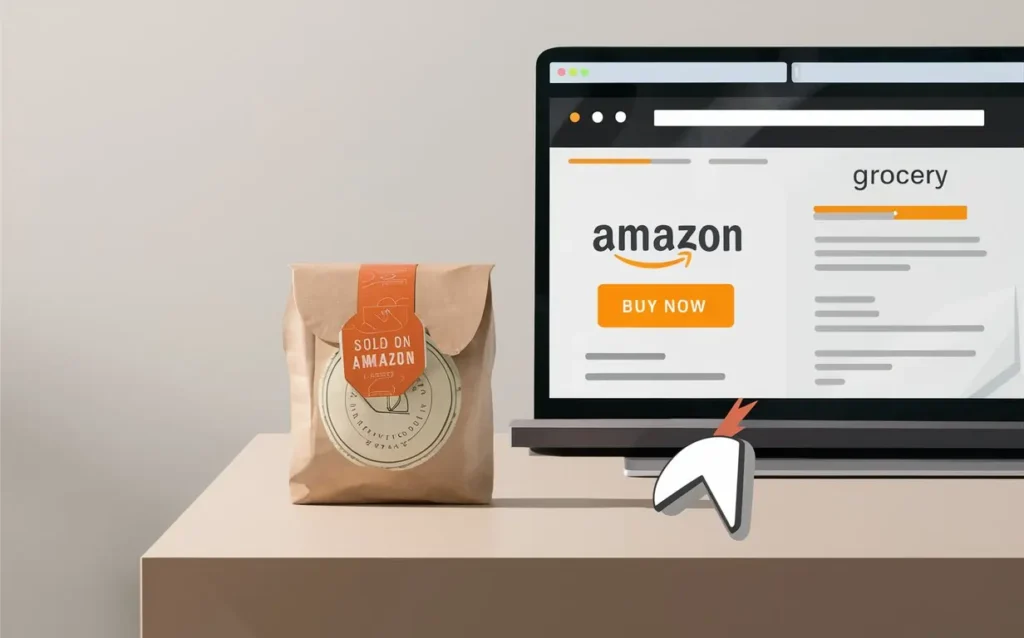
Venturing into the world of online sales? Selling food on Amazon might just be your golden ticket! With over 300 million active customer accounts, Amazon stands as a colossal marketplace where every minute detail can turn into a significant profit. Think of gourmet snacks or essential groceries, Amazon's platform offers an incredible opportunity to reach a vast audience eagerly searching for their next purchase.
In 2024, the E-Commerce giant is expected to see a growth of 8.9% in grocery and gourmet food sales, reaching a staggering $40.50 billion showcasing a robust demand in this sector. This growth is driven by a consumer base that is becoming increasingly comfortable with purchasing food items online, supported by Amazon's seamless shopping experience and trusted delivery systems.
But, why sell food on Amazon?
It's simple: visibility, convenience, and scalability. From the comfort of your home, you can manage a business that reaches millions of customers nationwide. Plus, with features like Prime shipping and essential selling tools, Amazon not only enhances your ability to sell but also simplifies the logistics of reaching your customer's doorstep.
What Are Amazon's Food Selling Policies?
Selling food products on Amazon is a lucrative opportunity, but it comes with a set of stringent policies and regulations designed to ensure consumer safety. As a leading E-Commerce platform, Amazon takes food safety seriously, implementing rigorous standards that sellers must adhere to.
At the core of these policies lies compliance with food safety regulations. Amazon mandates that all food products sold on its platform meet the guidelines set by the U.S. Food and Drug Administration (FDA) and the U.S. Department of Agriculture (USDA). This includes proper labeling, handling, and storage practices to prevent contamination and foodborne illnesses.
Before listing their products, sellers must obtain the necessary licenses and permits from relevant authorities. The requirements vary depending on the type of food product and the seller's location.
Amazon also has strict policies regarding product listings and descriptions. Sellers must provide accurate and detailed information about their food products. Misleading or incomplete information can result in product removal and potential legal consequences.
Get Started With Selling Food On Amazon!
Embarking on your journey as a food seller on Amazon can be an exciting and rewarding venture. With millions of customers eagerly browsing the platform for their next culinary delight, the potential for success is vast.
Steps To Register As An Amazon Seller:
- Visit Amazon Seller Central and click on “Sign up.”
- Choose your selling plan (Individual or Professional).
- Provide your business information, including legal name, address, and contact details.
- Set up your payment method and tax information.
- Verify your identity and complete the registration process.
Necessary documentation and certifications (e.g., FSSAI, organic certifications)
Once your account is set up, you'll need to obtain the necessary licenses and permits for selling food products. The requirements vary depending on the type of food you plan to sell and your location.
Categories Of Food You Can Sell On Amazon

Embrace your culinary entrepreneurship on Amazon‘s vast marketplace, where a diverse array of food categories awaits your delectable offerings. From pantry staples to gourmet delights, Amazon provides a platform to showcase your products to millions of hungry customers.
The permissible food categories on Amazon include:
- Grocery & Gourmet Food: This category encompasses a wide range of non-perishable items, such as:
- Snacks (chips, cookies, candy)
- Beverages (juices, sodas, energy drinks)
- Baking ingredients (flour, sugar, spices)
- Pantry staples (canned goods, condiments, oils)
- Produce & Fresh Goods: Here, you can list your farm-fresh offerings, including:
- Fresh fruits and vegetables
- Dairy products (milk, cheese, yogurt)
- Meat and seafood
- Baked goods (bread, pastries)
- Specialty Foods: Indulge the discerning palates of food enthusiasts with gourmet, artisanal, and specialty food items, such as:
- Fine cheeses
- Premium chocolates
- Exotic spices and seasonings
- Rare delicacies from around the globe
Amazon's diverse food categories allow you to share your culinary creations with a global audience, bringing joy to their tables.
What Are The Restricted Food Items On Amazon?
However, Amazon's policies restrict the sale of certain food items to ensure consumer safety and compliance with regulations. Among the prohibited items are:
| Restricted Items | Examples |
|---|---|
| Alcohol | Beer, wine (except from pre-approved sellers), spirits |
| Animal Products | Horse meat, Meat imported from China |
| Controlled Substances | Certain prescription drugs, illegal drugs, Illicit substances |
With the exception of wine sold by pre-approved sellers, alcoholic beverages are generally not permitted on the platform.
Additionally, Amazon enforces stringent guidelines for organic food products. If your offerings claim to be organic or bear the USDA organic seal, you must provide valid organic certification to ensure compliance with all applicable regulations.
It's crucial to review Amazon's restricted products list before listing any food items to avoid potential issues or product removals. By adhering to these guidelines, you can confidently showcase your culinary creations to a global audience while prioritizing consumer safety and regulatory compliance.
Fulfillment Options To Sell Food On Amazon
As a food seller on Amazon, choosing the right fulfillment option is crucial for ensuring your products reach customers fresh and in pristine condition. Amazon offers several fulfillment solutions, each with its own advantages and considerations.
1. Fulfillment By Amazon (FBA) For Food Items
Fulfillment by Amazon (FBA) is a popular choice among food sellers, offering a seamless and efficient way to manage the logistics of storing and shipping your products.
FBA stands for “Fulfillment by Amazon”. It is a fulfillment method provided by Amazon for third-party sellers on its marketplace. With FBA, you send your inventory to Amazon's fulfillment centers, and they handle the rest – from storage to picking, packing, and shipping your orders.
One of the key benefits of FBA for food sellers is the temperature-controlled environment in Amazon's fulfillment centers. This ensures that perishable items like fresh produce, dairy products, and frozen goods remain in optimal condition during storage and transit.
Alternatives to FBA for Food SellersWhile FBA offers convenience and reliability, some sellers may prefer to handle fulfillment themselves. Amazon provides two alternatives:
| Fulfillment Option | Description |
|---|---|
| Fulfillment by Amazon (FBA) | Amazon handles storage, picking, packing, and shipping |
| Easy Ship | You handle shipping, Amazon provides labels and customer service |
| Self-Ship | You manage the entire fulfillment process |
2. Fulfillment By Merchant (FBM)
Fulfillment by Merchant (FBM) is another alternative to FBA, where sellers handle the entire fulfillment process themselves, including:
- Storing inventory
- Picking and packing orders
- Shipping to customers
- Handling customer service and returns
While FBM offers more control over the process, it also requires significant time, resources, and logistics management.
3. 3PL (Third-Party Logistics)
Many sellers opt to work with third-party logistics (3PL) providers like for FBM fulfillment. 3PLs offer specialized services, including storage, pick and pack, shipping, and customer service, allowing sellers to outsource logistics while maintaining control over the process.
“Working with a 3PL has been a game-changer for our business. It has allowed us to focus on our core competencies while ensuring efficient and reliable fulfillment for our customers.”
Kristina Lopienski, Director of Ecommerce at Source Brew Coffee
When choosing a fulfillment option, consider factors such as your product type, order volumes, storage requirements, shipping volumes, growth plans, and operational capabilities. As the saying goes, “One size doesn't fit all,” and the right choice can significantly impact your business's success on Amazon.
Packaging And Labeling Criteria To Sell Food

When it comes to packaging, Amazon mandates that all food products be securely contained to prevent damage or contamination during transit. Perishable items like fresh produce, dairy, and frozen goods must be shipped with appropriate temperature controls and insulation to maintain freshness and quality.
For individual units, each product must be properly labeled with accurate and detailed information, including:
| Information Required | Details |
|---|---|
| Ingredients | Complete list of ingredients |
| Nutritional Facts | Breakdown of nutritional values |
| Allergen Warnings | Clear labeling of potential allergens |
| Expiration Dates | Best-by or use-by dates |
Failure to provide this information can result in product removal and potential legal consequences.
1. Amazon also has specific guidelines for packaging materials. Polybags used for food items must have a suffocation warning label and a minimum thickness of 1.5 mils. Additionally, the bags must be properly sealed, with no openings larger than 0.25 inches.
2. For bundled or “sold as set” products, Amazon requires that all items be packaged together and clearly labeled as a set on the exterior packaging. This ensures that customers understand the products are intended to be sold as a single unit.
3. Proper labeling and barcoding are also crucial. Amazon mandates the use of scannable barcodes on all units, with specific requirements for label size, placement, and printer specifications to ensure readability and longevity.
Good Luck Selling Food On Amazon!
Selling food on Amazon is a lucrative opportunity that offers unparalleled access to a vast customer base. With a staggering 37.8% market share in the US E-Commerce space, Amazon provides a platform for your culinary creations to reach millions of hungry shoppers.
With a presence in over 20 countries, Amazon offers a platform to reach a diverse international customer base, enabling you to tap into new markets and expand your culinary empire beyond borders. This growth is fueled by consumers' increasing comfort with online grocery shopping and Amazon's seamless shopping experience.
A journey through the intricate world of food sales on Amazon requires a deep understanding of the platform's stringent policies and regulations.
From obtaining necessary licenses and permits to adhering to packaging and labeling guidelines, compliance is paramount to ensuring a smooth and successful selling experience.
By embracing Amazon's vast array of tools and resources, such as Fulfillment by Amazon (FBA), advertising platforms, and global marketplaces, you can streamline your operations, enhance visibility, and scale your business to new heights.
Seize the opportunity to share your culinary passion with a global audience and turn your food business into a thriving, scalable venture on the world's largest e-commerce marketplace!







